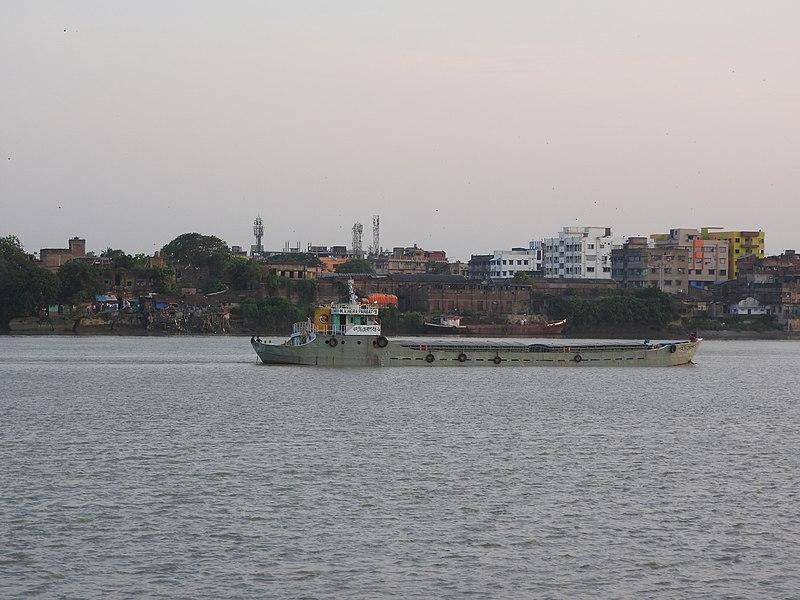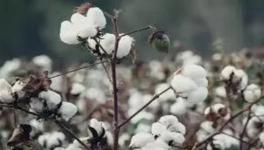Modi Government’s Grand, Flawed, Expensive Waterway Project

National Waterway 1 | Image Courtesy: Wikimedia Commons
Prime Minister Narendra Modi inaugurated the National Waterway-1 in Varanasi in 2018, which sent the signal that India would create a web of inland waterways. The argument was that waterways would lower the dependence on fossil fuels. To mark 5 June, World Environment Day, NewsClick speaks to Avli Verma and Shripad Dharmadhikary of the Manthan Adhyayan Kendra, a non-government organisation that researches water issues. In 2017, the Manthan Adhyayan Kendra and SRUTI had published “National Inland Waterways in India: A Strategic Status Report”. In March, it released another study, “Grand Plans Many Questions: A Status Review of Claims, Progress and Impacts of the National Inland Waterways Program”. Speaking on its findings and recent developments, Dharmadhikary and Verma say the project was “greenwashed” into existence, meaning that environmental benefits were touted to push through an ecologically harmful and economically non-viable project. Edited excerpts.
The Prime Minister inaugurated the National Waterway-1 with a great deal of pomp and show in Varanasi in November 2018. It was projected that millions of tonnes of cargo would move to the waterways. What is the reality?
The real figures certainly show that the projections are hyped. A PIB [press information bureau] bulletin on 6 December 2018 said the volume of traffic on the inland waterway to Varanasi is expected to increase once the multi modal terminal being built under the Jal Marg Vikas Project (JMVP) is commissioned and the “estimated volume of traffic for Varanasi multi modal terminal would be 3.55 MMT by 2020”. But in 2018-19, only three vessels were handled at the Varanasi terminal and in 2020-21, no vessels were handled.
So, despite the fanfare, a loan from the World Bank and some budgetary support, the scheme has still to kick off. Could you explain why?
The World Bank support for the JMVP [Ganga Waterway], together with two other loans from the World Bank (about Rs.1,400 crores) and the budgetary support, do not add up to a significant amount compared with the funds needed to develop a waterway. So, it is not surprising the physical development of the waterways has been slow.
[However] the main factor is the basic underlying unviability of many of the waterways, the fact that cost of transport by these waterways is not really lesser than by other modes as claimed. This means, the economic push for the waterways is also not as strong.
Studies in 2020-21 show that 63 of the 106 projected National Waterways announced in 2016 are viable. Were the earlier projections made without any basis?
From the beginning, we have raised concerns on the feasibility of these waterways. The viability and economic superiority of waterway transport has been projected based only on that part of transport that takes place on water whereas we need to consider the actual costs—which means transport over the non-waterway sections too. That is, the actual cost of transport of goods from origin to water terminal and from water terminal to destination needs to be accounted for.
The Action Plan for Development of National Waterways brought out by the Inland Waterways Authority of India (IWAI) in April 2020 struck a note of caution by pointing out the high costs of creating and maintaining the waterway, lack of cargo or passenger traffic demand, obstructions such as low bridges, the high cost of removing these and lack of adequate depth and water in many proposed waterways.
Of course, these reasons were well-known even when the waterways were being planned. So, to put them forward now indicates the earlier projections were based on incomplete analysis and unfounded optimism by ignoring vital facts.
A RITES report says that to fully develop six national waterways would require Rs. 227.6 billion. How does the government plan to raise this money? Does this finding mean inland waterways are much cheaper than road transport?
Apart from IWAI allocations which essentially are budgetary allocations, there are provisions for annual allocations from the Central Road and Infrastructure Fund as well. Further, allocation for the Sagarmala project also contributes to the development of National Waterways to an extent. Other sources of funds include extra-budgetary resources such as raising bonds, inviting the private sector and private funds under PPP mode. Even taken together, the amount cited above looks difficult to achieve. Part of the reason is the underlying unviability of the waterways, which has made raising extra-budgetary resources as well as PPP difficult.
Is that why on the one hand lower cost is touted as a major advantage of the waterways compared to railways and roads, and yet the IWAI has not released any cost data for the operational waterways?
Developing and building inland waterways is highly capital intensive. Even maintenance and associated infrastructure requires significant cost. But the cost of transport using waterways needs to include the totals costs of door-to-door delivery. This often makes the cost comparable to at least rail transport. For example, as per data provided on the World Bank website, there has been no reduction in the cost of transporting cargo on the Ganga waterway. It was Rs. 1.11 per ton-km on 1 Jan 2017 and remained the same as on 21 Dec 2020 after several years of work on the project.
As per the 2014 RITES report on the Integrated National Waterways Transportation Grid (INWTG) the cost of cargo transport by rail is Rs. 1.36 Rs/ton-km. Given that one needs to consider the entire origin-to-destination cost, it seems clear that even the flagship Ganga waterway project is not really more economical than rail transport.
The IWAI not giving figures for cost of transport of goods for all the waterways needs to be seen in this light. It should be kept in mind that apart from the issue of waterways not being able to provide door-to-door delivery, the total distance by waterway can also be higher than the rail or road distance, thus often offsetting the cost-differential.
For the present, the government seems to have decided to focus largely on National Waterway 1 along the Ganga, and National Waterway 2 on the Brahmaputra. But even here there are innumerable examples of vessels getting stuck due to lower water levels. Between March 2020 and May 2020, five fly ash laden barges sank in various stretches of Hooghly rivers and rivers of the Sundarbans. What does this indicate?
The focus is mostly on NW-1. We have listed various cases in our new report in which barges have gotten stuck in the river due to inadequate depth due to lack of vertical clearance when the depth was more than adequate due to the monsoon. In a recent pilot movement from the Varanasi terminal, the vessel took more than usual time in reaching Gaighat in Patna due to the Pontoon bridges on the way.
This reflects poorly on the foresight of the planners and regulators. Sinking of fly ash barges in the Hooghly and other stretches of the Indo-Bangladesh Protocol routes represent the really hazardous aspect of the inland water transport which is that toxic cargo that escape from the capsized ships can travel some distance in the river. Further, it is extremely difficult to salvage the vessels.
Until August 2020, none of these vessels were salvaged. So even the fuel oil from the cargo ship would have escaped into the rivers. It shows that waterways are not inherently safe to transport bulk and toxic dirty cargo.
Another key problem is the lack of industries along the Ganga and the Brahmaputra, especially the latter, which means there will be little cargo commitments by private companies. So where will these barges get the volume of trade from?
The main push is on providing an alternate route of transportation using the Indo-Bangladesh Protocol route to connect the North Eastern Region to the mainland (Navigation from Brahmaputra to Ganga via Bangladesh). Goods, including raw material and finished goods, can be transported to the northeastern region from the mainland and vice-versa.
The other problem your report cites with inland water transport is that a river needs enough depth throughout the year to be viable as a waterway. But since most of our rivers require extensive dredging, that adversely affecting the ecology of the river.
Dredging involves removal of silt, rock, sand and clay from river beds. The ecological continuum of the river is directly damaged due to this action. Dredging physically cuts and damages the river bed, and can lead to change in habitat for various aquatic flora and fauna. Dredging also leads to turbidity and noise, further affecting river fauna.
In case the channel creation requires cutting into the river bed, there is a good chance that local aquifers would be cut. This can result in loss of water from river, or loss of groundwater from the surrounding areas. Dredging can release settled pollutants in the river water and thus increase the pollution load. Dredged material can also lead to problems if dumped in the other channel of the river by adding siltation in the fishing sites.
Is Bangladesh using inland water transport?
Presently, India’s modal share of the IWT is 2.5%. Bangladesh, because of the climate related changes, is in a situation where the flow of its waterways has become erratic. Inland navigation is becoming more hazardous due to increased siltation and waterways are shrinking rapidly.
We had 18 operational waterways such as the Amba Waterways, Goa Waterways and Sundarbans Waterways. So why did the NDA government launch such a grandiose project, considering the creation, maintenance and operation of inland waterways has adverse environmental and social impacts?
We don’t know. In this project, the declaration of rivers as National Waterways was done first, and the studies to examine their feasibility were initiated later. It should have been the other way round with proper consultation and discussion with the local population, vulnerable groups, and environment experts. It was a top-down decision by the government. Public consultations are still not done for many of these projects. Comprehensive prior impact assessments also needed to be done, which was not done.
Dredging is a highly intrusive activity that can damage river bed habitats, and along with river straightening and training works, river protection works have severe impacts on habitat and ecology. The operation of vessels leads to leakage of oil and lubricants, heightened noise and turbidity, all with serious impacts on the flora and fauna. Bank erosion due to vessel movement is another major impact. Impacts on the aquatic ecosystems were greenwashed with the claims of saving on the burning of fossil fuels and reduced air pollution.
The IWAI asserts that waterways are the “best suited mode of transportation for … hazardous goods…” What would you say?
Accidents on inland waterways involving toxic and hazardous goods, as well as leakage of oil and lubricants during routine vessel movement, all have far reaching impacts on the riverine ecology. These accidents are harder to contain and mitigate. On the surface, it might not be visible but there could be changes in the under-water domain which are difficult to capture as it is a flowing dynamic medium. Pollution can severely impact livelihoods, especially those of fish workers, and health of people directly dependent on the rivers.
National Waterways and their components such as the Multi-modal terminals are being kept outside of the legally binding Environmental Clearance Process. What are the implications of such a move?
There are serious implications. With no legally-binding environment clearance requirement, the monitoring of impacts is being done by the very same authority that is in charge of developing the waterways. Which project promoter will come forward and accept their project is polluting the environment? In a legally binding environment clearance process, the project will have to do the baseline study i.e. to reveal the state of the environment as of now.
They will be asked to prepare an Environment Impact Assessment including the examination of the impacts of several specific aspects of the project on the basis of the Terms of References suggested by an Expert Appraisal Committee. This report will then be taken to the local population, explained to them, and their concerns would be added and duly addressed in the mitigation measures specified in the report. Conditions and mitigation measures made under a legally binding environment clearance have much more accountability and any concerned citizen can challenge non-compliance in the court if they have genuine grievances.
The authorities are now keen to promote high end tourism with luxury cruises and seaplanes on the waterways. Is this a possibility? These days there is news of corpses on the Ganga...
The situation is dire at present but the concerns will remain even when the situation normalises. The promised high-end tourism can have serious adverse impacts on the small boat operators and users. While high-end tourism could be aspirational for a certain section of society, many will not be able to afford these services.
Get the latest reports & analysis with people's perspective on Protests, movements & deep analytical videos, discussions of the current affairs in your Telegram app. Subscribe to NewsClick's Telegram channel & get Real-Time updates on stories, as they get published on our website.























